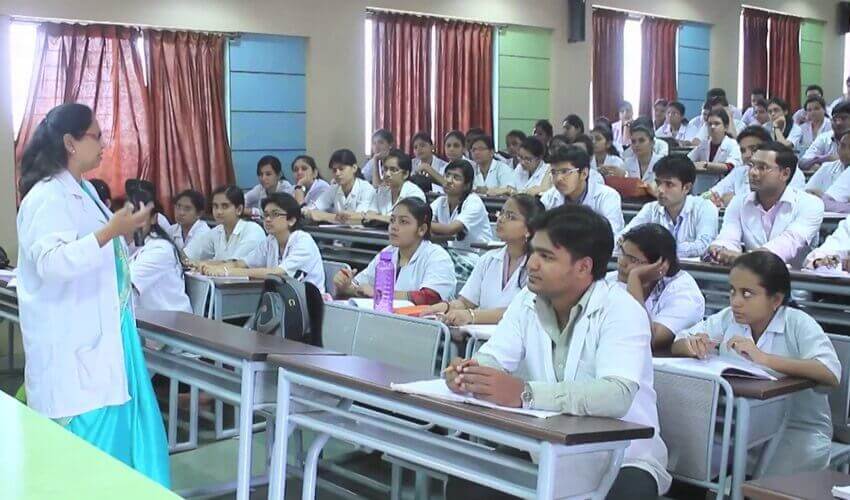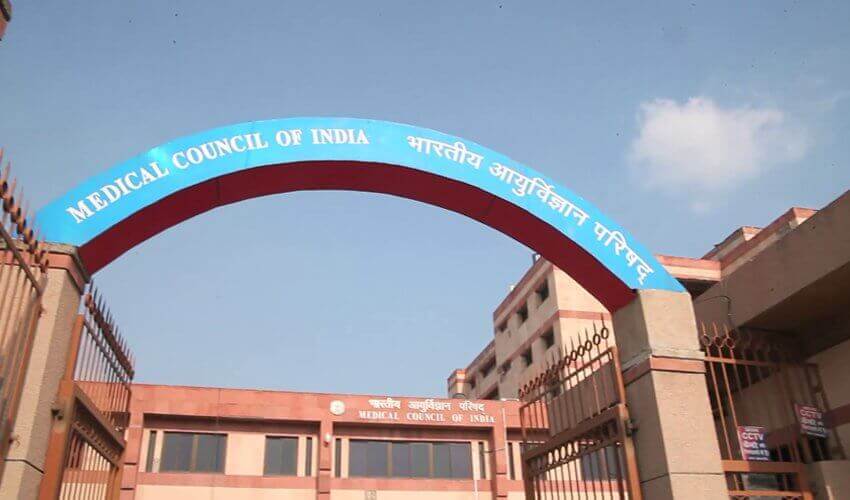
Also read: National Exit Test
The Paradox of Medical Care in India
India has the largest number of medical colleges and is also a booming market for medical tourism, but a large majority of citizens does not have access to the basic healthcare facilities. The doctor-population ratio is far lower than prescribed by World Health Organisation (one for every 1,674 persons, as per the parliamentary panel report, against the WHO-recommended one to 1,000).
Medical Council of India (MCI)
Management of medical education in India should take the major responsibility of such a paradoxical trend. Medical Council of India (MCI) is the regulatory body for medical education and medical practices in India. Many blame MCI for problems in the India health sector. The solution to this situation lies mainly in reforming and revamping MCI.
However, Medical Council of India (MCI) has conducted many studies to identify the problems the medical field (Eg: Vision 2015 Report).
Vision 2015 report of MCI
MCI published a vision document, in which it has analyzed problems of healthcare sector and reforms needed to resolve them.
- 3 main reasons for India’s healthcare woes:
- Shortage of physicians (both generalists and specialists).
- Inequitable distribution of manpower and resources.
- Deficiencies in the quality of medical education.
- Proposed reforms:
- Increase production of doctors.
- Reform curriculum by a transition from a science-based curriculum to skills and competency-based curriculum.
- There is a need to emphasis on primary health care and family medicine.
- Medical institutions should be strengthened by investing in technology.
The final goal of the vision document is to produce world-class Indian doctors. Needless to say, this vision remained a mere vision, even in 2018, without any marked improvement in ground reality.
The Problems of Medical Education in India

Medical education in India faces many issues, some of which are identified in the vision document. Most important of them are:
1. Inter-state and intra-state inequality in the distribution of manpower and resources
- There is a huge disparity in availability of opportunities for students across states.
- 2010 report by MHRD had stated that four states – Andhra Pradesh, Karnataka, Maharashtra and Tamil Nadu – account for 1.3 lakh out of 2.4 lakh medical seats across India.
- There is also a glaring rural-urban disparity in both availabilities of health care and colleges.
- A blanket standard for starting a medical college leads to neglect of states like Arunachal Pradesh, Mizoram, Nagaland etc. and rural areas.
- Amidst this situation, new medical colleges can bring in uniformity of access across sates and fill the demand-supply gap.
2. Low doctor-population ratio
- One of the reasons for this low ratio is that only low number of medical graduates are passing out each year. Reasons include:
- As MBBS students are unable to find jobs, they are forced to specialize in a particular field leading to a Super-Specialty craze.
- Brain drain to developed countries is also one of the reasons for unavailability of doctors in India.
- MCI regulations prevent experienced MBBS doctors from carrying out procedures like cesareans and ultrasound tests. Experienced nurses are barred from administering anaesthesia. This leads to failure of utilizing the experienced manpower to increase the service delivery.
- This shortage of doctors is largely affected by rural health care.
- Another casualty of the Super-specialty craze is Research and teaching, as no one is choosing research or teaching as their preferred career.
Single breed of doctors can’t cater to all the needs, especially in a country as diverse as India. So medical colleges should sensitize students about all the available opportunities and the attached perks and perils. This will introduce various options available to the students to explore and choose the field best applicable to them.
3. Deficiencies in the quality of medical education
- There is no uniformity in selection students to medical colleges. A common entrance test at all India level is required to ensure this uniformity.
- Breakthroughs are frequent in the medical field, but syllabus is not updated adequately reflecting these new trends in the medical field.
- Lack of skilled teachers has afflicted all the educational paradigms of India. In the medical field, this issue is more critical. Here teachers are selected based on academic knowledge rather than clinical experience and adequate training is not imparted to them. Inadequate salary to teachers is also the main problem that makes this profession unattractive.
- No uniform quality standards of graduating doctors across India. There should be an exit test, that will bring parity to standards graduating from all medical colleges across India.
4. Lack of social accountability
- The medical profession is unique as it requires an amount of social responsibility and societal empathy. Newly graduated doctors are unaware or indifferent to their social responsibility. Colleges play a major role in infusing the young students with an empathetic attitude towards society. But instead, they are encouraging rot learning without the consideration of humanitarian dimension. Hippocratic oath is largely morphing into hypocrisy.
5. The recognition issue of foreign degrees
- MCI recognizes only a few medical courses from foreign universities. This becomes difficult for foreign graduated students to start practising in India.
6. Unregulated private colleges
- Change in rules brought about after the reforms of the 1990s made it easier to open private colleges. This has increased the number of medical colleges but leads to many undesired consequences.
- This commercialization of medical education had a profound impact on quality of graduate doctors, as anyone with money can buy seats in these colleges.
- MCI was incompetent to deal with this influx of commercialization and capitation fee skyrocketed, leading to corruption and black money circulation.
- Thus sanctity of education was lost as medical education became a field for unscrupulous practice and profit gain than imparting education and providing quality doctors. This has resulted in an unhealthy competition which in-turn lead to unreasonable medical practices and unwarranted diagnostics as graduates from these institutions wanted to recover their capitation fees at the earliest. Eventually, this leads to complete crowding out of the societal and humanitarian dimension of medical education from colleges.
Medical Council of India (MCI) – History | Objectives | Issues

Indian education system is regulated by Medical Council of India. From setting standards of education to approving colleges and setting ethical guidelines for doctors, are vested in this single institution. So the working of the same will be the main determinant of the success of medical education in India. Given the maladies of the medical education system, an overhaul of MCI is the first and foremost step of rescuing the medical system from its current rot.
History of MCI
- MCI is a statutory body for establishing uniform and high standards of medical education in India.
- It was established in 1934 under the Indian Medical Council Act, 1933. It later reconstituted under the Indian Medical Council Act, 1956.
- But the controversy over corruption plagued the institution as it was dissolved by the President of India in 2010 following the arrest of MCI’s president Ketan Desai under the Prevention of Corruption Act.
- It was then reconstituted in 2013. After several committee reports and court orders, the government introduced National Medical Council bill in 2018.
Objectives of MCI
- Maintenance of uniform standards of medical education, for both undergraduate and postgraduate courses.
- Recommendation for recognition/de-recognition of medical qualifications of medical institutions of India or foreign countries.
- Permanent registration/provisional registration of doctors with recognized medical qualifications.
- Reciprocity with foreign countries in the matter of mutual recognition of medical qualifications.
Issues of MCI
- Separation of regulatory powers
- The council regulates medical education as well as medical practice leading to the centralization of all regulatory functions in one single body.
- There should be a separation between the regulation of medical education from regulation of medical practice. Expert committee- Ranjit Roy committee 2014 –recommended structural re-configuration of the council by separation of power.
- Composition of MCI
- Most of the members of the MCI are elected.
- NITI Aayog Committee (2016) noted that there will be a conflict of interest if members are elected. Because if the regulator is elected by the same fraternity that it would monitor, it will become ineffective and also prevents the entry of skilled professionals for the job. The Committee recommended the appointment of regulators through an independent selection process than elections.
- Fee Regulation
- MCI is authorized for fee regulation of private colleges.
- NITI Aayog Committee (2016) recommended against this practice as it will lead to corruption and increased capitation fees. Fee cap will discourage the entry of genuine private colleges, limiting the expansion of medical education in the country. Disallowing for-profit medical education has driven profit-taking underground with various kinds of inventive fee structures by medical colleges.
- Professional conduct
- Standing Committee on Health (2016) observed that the present focus of the MCI is only on licensing of medical colleges and no emphasis given to the enforcement of medical ethics in education and on instances of corruption noted within the MCI.
- Committee recommended that the areas of medical education and medical practice should be separated in terms of enforcement of the appropriate ethics for each of these stages.
Thus, now MCI has evolved into a body that has become a powerful rationing authority, controlled by those who it is supposed to be regulating, that is powerful medical colleges and medical professionals.
Various Committees on Medical Education in India
1. Ranjit Roy committee 2014
Amidst these crises, the government appointed a high power committee under the chairmanship of Ranjith Roy to look into the issue comprehensively and recommend reforms. Thus the committee has given recommendations, which form the basis of current restructuring of medical education in India. Important recommendations are:
- An umbrella body – National Medical Commission (NMC) should be constituted through a new act
- National Medical Commission should have an Appellate Tribunal and four independent and autonomous boards viz.
- Under-Graduate medical Education Board (UGMEB),
- Post-Graduate Medical Education Board (PGMED),
- Medical Assessment and Rating Board (MARB)
- Ethics and Medical Registration Board (EMRB).
- Steps to be taken to decrease the cost of medical education in India.
- Regional accessibility should be increased.
- Doctor to patient ratio should be increased.
- Common entrance exam should be conducted.
A parliamentary committee to overhaul MCI was constituted to study Ranjith Roy committee report.
2. Parliamentary standing committee to overhaul MCI 2016 – Prof Ram Gopal Yadav
Major observations of the committee are:
- The committee called MCI a “club” of influential medical practitioners who act without any fear of government and regulations.
- There was widespread corruption in granting approval for setting up medical colleges and prevalence of ‘random’ and opaque inspections as a scrupulous method for corruption.
- The committee finds MCI as responsible for the prevailing pathetic state of health care and low standard of conduct of medical practitioners and hospitals.
- It opined that the composition of MCI neither represent professional excellence nor follows medical ethos. More than half of the members are either from corporate hospitals or in private practice, carrying out unnecessary diagnostic tests and surgical procedures and flouting government rules and regulations, especially about treating patients from underprivileged backgrounds.
The committee asked the government to implement Prof Ranjit Roy Chaudhury committee. The government has introduced NEET exam as a common entrance test from 2016. But on other recommendations, government dragged its feet. Supreme Court ordered an oversight committee under Justice Lodha. Thus the inefficiency of government or executive paved the way for judicial activism.
3. Oversight committee under Justice Lodha 2016
Supreme Court set up an oversight committee under Justice Lodha while endorsing Parliamentary standing committee report, through Article 142, to bring in transparency and accountability within the MCI and oversee its statutory functioning. But a turf war between the Supreme court established the oversight committee and MCI hindered reform measures Then the government-appointed a team of five eminent doctors to oversee the medical regulatory body as the 1-year mandate of oversight committee ended.
National Medical Council Bill 2018 – Concerns and Solutions

Thus we have seen that there are many maladies in medical education in India, most of which roots back to the inefficient functioning of the regulator, the MCI. After a parliamentary committee report and an oversight committee by the Supreme Court, finally, the government have introduced a new bill, titled National Medical Council 2018. It is currently being debated in parliament. As the bill is being debated, we will look into the issues that are needed to be addressed in the bill:
#Issue 1 – Inequitable distribution of manpower and resources
- A fixed percentage of seats in each private colleges with government-determined fee structure will cater to economically underprivileged meritorious students. This can meet the issue of access to medical education by weaker sections.
- Removing bottlenecks to starting colleges, such as conditions stipulating the possession of a vast extent of land and needlessly extensive infrastructure, will considerably rectify the imbalance, especially in under-served States. The primary criterion to set up a college should only be the availability of suitable facilities to impart quality medical education.
#Issue 2 – Low doctor-population ratio
- Ending the fee cap and allowing private medical colleges to start new for-profit colleges.
- This will meet the supply side constraints of medical practice in India by increasing number of doctors. It will also eliminate the regulatory-capture of the medical field in India.
- this will also reduce corruption and black money generation simultaneously increasing the government revenue. Also, competition among private colleges will decrease the fees, making medical education accessible to all sections of society.
- Bridge courses which allow alternative-medicine practitioners (AYUSH) to prescribe modern drugs. (in line with barefoot doctors in China) can broad-base pyramid of health sector by increasing doctors in primary and secondary sector.
- Empowering experienced doctors and nurses for taking additional responsibilities will be a method for optimal utilization of experienced manpower to give health care services.
- three-year diploma course for rural medical-care providers, in lines of the Licentiate Medical Practitioners(before 1946), to take up the additional responsibilities of the healthcare sector
- Leverage practitioners in AYUSH to meet doctor deficit through cross-practising. Shailaja Chandra report 2013 had opined that National Rural Health Mission had recruited AYUSH physicians as the sole care provider in many states, which were effective in meeting the requirement of health care providers. The report recommended training those AYUSH physicians to meet demands in Primary Health Centres.
#Issue 3 – Deficiencies in the quality of medical education
- National licentiate examination for doctors to practice medicine can help to restore public confidence in the competence of medical practitioners by ensuring uniform quality standards across India. Entrance level non-uniformity is met with the introduction of NEET
- Indian healthcare system should incorporate the Psycho Socio-Ecological (PSE) model of health. PSE focuses on social determinants of health with an emphasis on health promotion and disease prevention
- Medical education pedagogy should be improved by frequently revamping syllabus with respect to new breakthroughs in the medical field. The curriculum should include training on emerging technologies and models of healthcare delivery.
- India doesn’t follow the use of OSCEs (objective structured clinical exams) to test medical candidates. Thus, their clinical skills are not tested till they start practising.
#Issue 4 – Lack of social accountability
- Need to align medical education with societal needs and expectations than work in isolation. For this community-based education is needed.
#Issue 5 – Revamping MCI
- Separation of power between medical education and medical practice should be the first step in reforming the MCI.
- There should be an independent selection committee to select members in NMC than electing the members as is done previously with MCI.
- the annual inspection should be scrapped with one-time registration and licensing, thus nullifying the scope of corruption through random inspections.
- There should be an independent accreditation and rating agency to inspect and rate colleges on basic standards and a penalty for not conferring with set standards.
- To reflect interests and concerns of states, an advisory body consisting of representatives from all states and UT should be constituted to advise NMC. Because each state have varied requirements and for a federal nation like India, a one-size-fits-all policy is not suitable. This will lead to issues, like that of Tamil Nadu during the implementation of NEET, to crop up.
Conclusion
Indian higher education system has a common problem concerning with incapacity of regulators like UGC, AICTE, MCI etc. A common problem of these institutions is the concentration of power as they regulate both educational practices and professional practices leading to a conflict of interest. There is a need for comprehensive reforms to usher in governance reforms for cleansing Indian higher education system of its maladies.
Moreover, all stakeholders should acknowledge that medical education has a special sanctity in itself. This should not be lost to the altar of profit-making.
As from above discussion, it is clear that a complete surgery of Indian medical education system is needed in order to cure cancer with which it has been afflicted. NMC act will be a watershed act in this respect. For a bill of such huge scope, it is prudent to have wide-ranging debates and discussions. So delay in the passage of the act is worth the while for waiting.
Article by: Sethu Krishnan M
References: PRS blog, The Hindu, Wikipedia, Hindustan Times, New Indian Express, India Today






Very well articulated and precised info that is prudently required.
Thanks Mr.Krishnan.
thank u soo much
Thank You So Much ❤️✨ WELL CLARIFIED NOTES